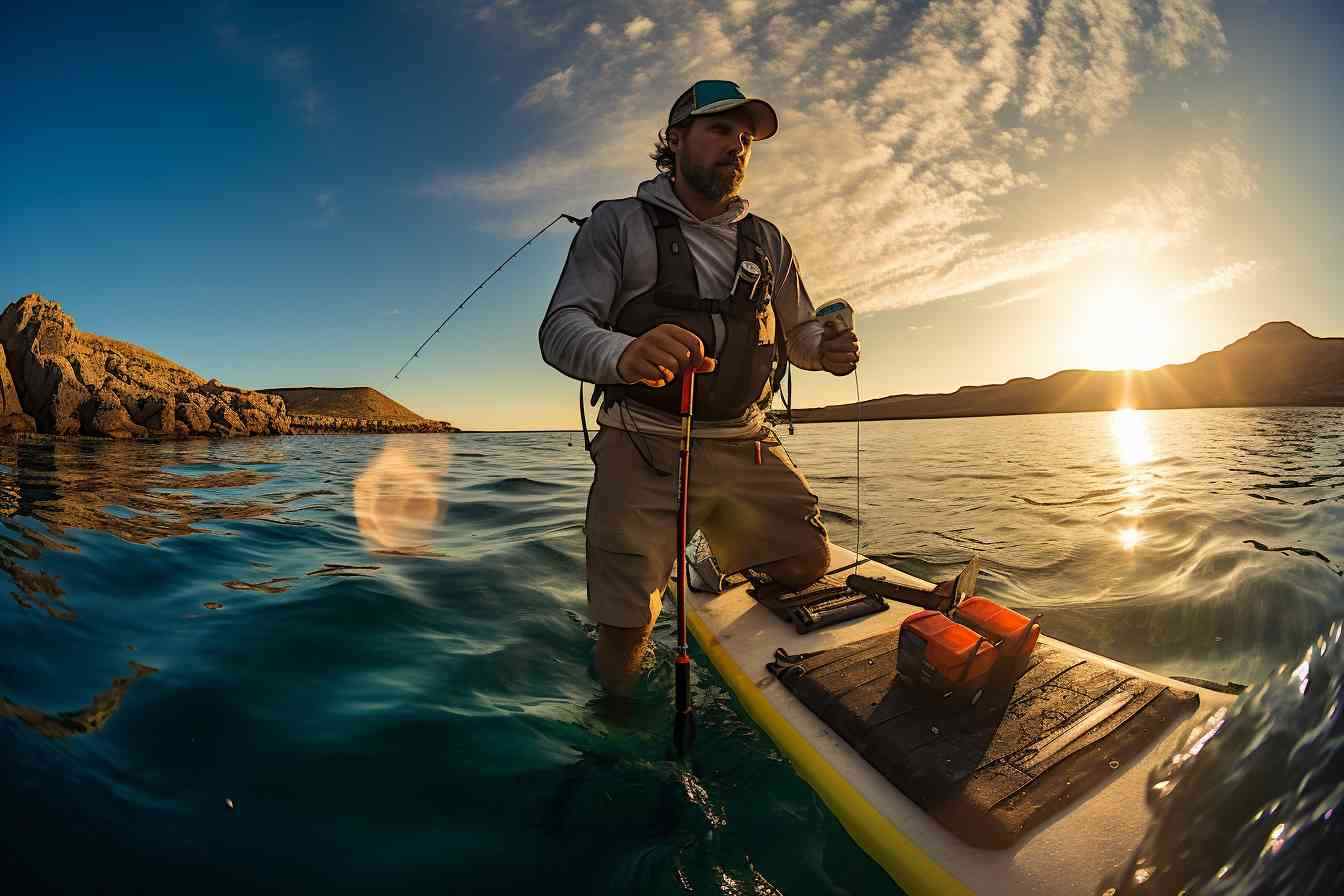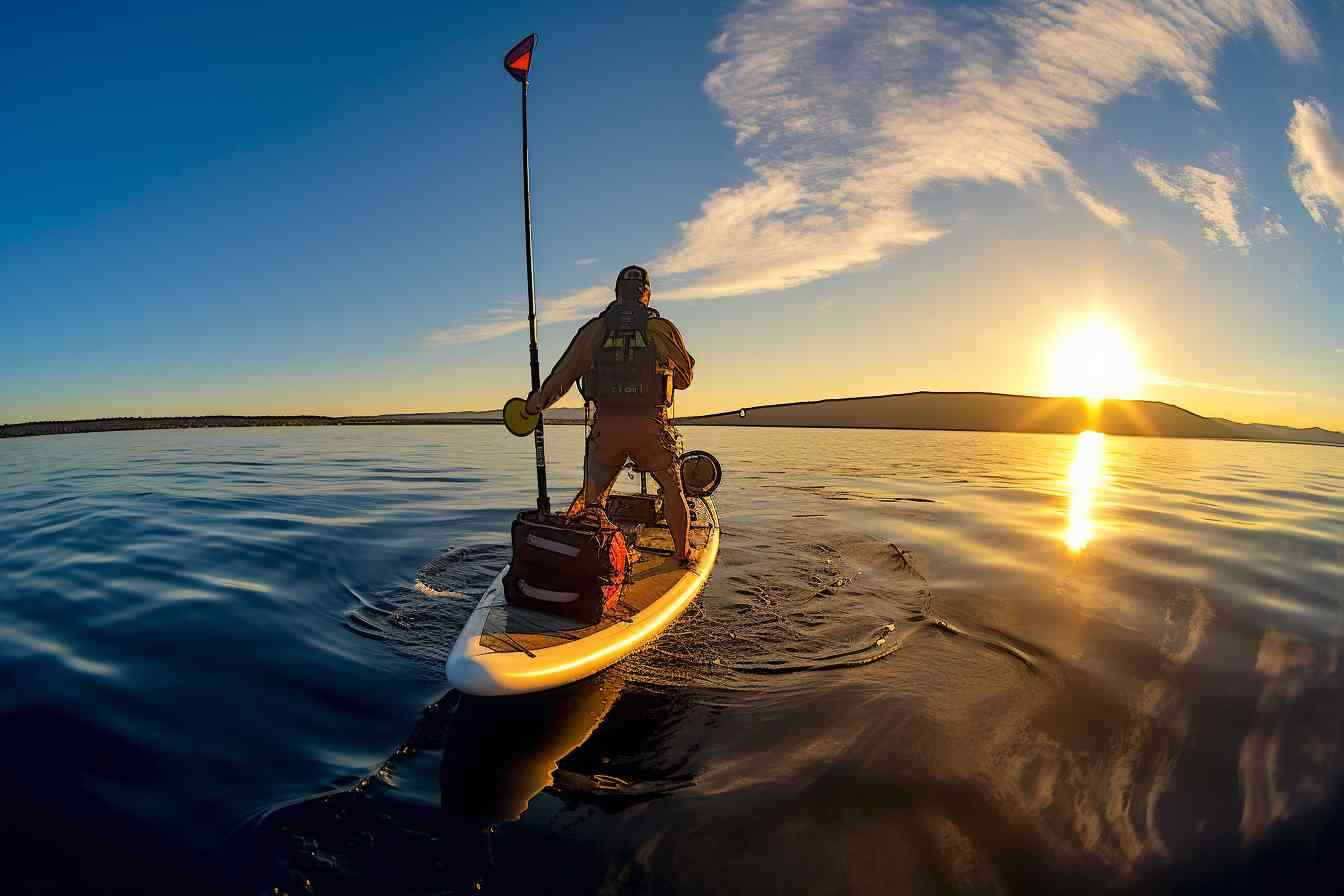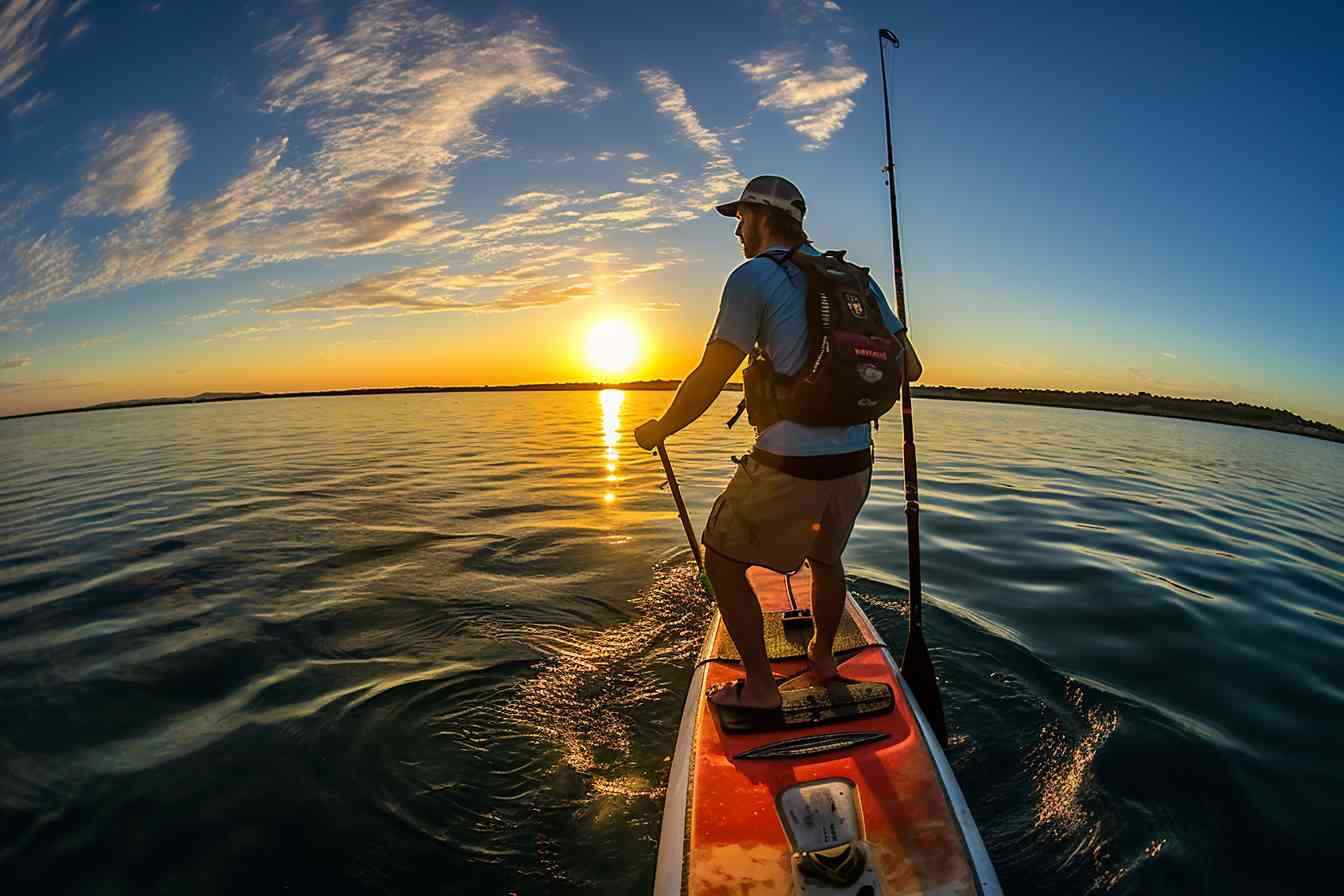Master the Ultimate Paddle Board Fishing Setup Welcome to SUP Fishing Club

Summary
- Intro: How To Create The Best Paddle Board Fishing Setup: Join The Sup Fishing Club
- How Do You Set Up A Sup For Fishing?
- How Do You Set Up A Sup Paddle?
- How Do You Connect Paddleboards Together?
- How Many Fins Is Best On Sup Board?
- Final Verdict
- Frequently Asked Questions
- What’s the first step to setting up a paddle board for fishing?
- Can I use any paddle board for fishing or do I need a special one?
- What gear should I bring for a SUP fishing adventure?
- Do I need an anchor for my paddle board when fishing?
- How do I avoid flipping my paddle board while fishing?
- Is a fishing license required when fishing from a paddle board?
- What kind of clothing should I wear for SUP fishing?
- How do I store my catch on a paddle board?
- What’s the best way to cast from a paddle board without falling in?
- Is it better to fish solo or with buddies when SUP fishing?
- Any tips for dealing with fish smell on the paddle board?
- Related Video
- Frequently Asked Questions
Intro: How To Create The Best Paddle Board Fishing Setup: Join The Sup Fishing Club

Choosing Your SUP Fishing Gear Man, getting the right gear for your SUP (Stand Up Paddleboard) fishing adventure is key, I tell ya. It’s not just about grabbing any old paddleboard and hitting the water! It’s gotta be stable enough to stand on for hours, you know? And space is a premium on these boards, so every item counts. Opt for a paddleboard designed for fishing, with mounts for your rod holders and enough room for a cooler or a tackle box. A tip? Look for boards with bungee straps and D-rings to secure all your gear. Trust me, you don’t want to be chasing your stuff in the water.
Setting Up Your Paddle Board Alrighty, when setting up your paddle board, it’s about balancing your space and gear. Hauling a heavy load can be a huge bummer, so pack smart. Fix your rod holders near the board’s edges, and if you’ve got a cooler or a seat, strap ‘em down in the middle. This way, you’ve got room to move and fish without tripping over your gear. A little bit of foresight goes a long way. I always make sure that everything’s within an arm’s reach, so when the fish bite, I’m not fumbling around.
Staying Safe and Dry Okay so, safety first, right? Always wear a life jacket. No arguments here. It’s a no-brainer considering you’re surrounded by water! Look out for a PFD (Personal Flotation Device) that serves double duty with pockets - they’re nifty for stashing small items. And since staying dry is half the battle, water-resistant clothing and a dry bag for essentials are must-haves. I mean, nobody wants to be soaked to the bone when the chill sets in. Remember, you’re going to spend a good chunk of your day on the water, so comfort is as important as staying dry.
Accessorizing for Success Gee whiz, accessories can make or break your SUP fishing game. A good anchor system can keep you in the sweet spot without drifting away – it’s been a game-changer for me. And let’s talk tech for a second – a compact, waterproof fish finder can seriously up your fishing game. Also, those clip-on cup holders? They’re swell for keeping your drink safe. My advice, don’t skimp on the handy add-ons, they often make the biggest difference out there on the water.
How Do You Set Up A Sup For Fishing?

Oh boy, gearing up a SUP for fishing is like turning your quiet little paddleboard into a stealthy fish-stalkin’ machine! It’s all about balance—like yoga, but you get to catch dinner. First off, scope out a board with enough deck space. You’re gonna want room to do your fishing dance without taking an unexpected dip. Trust me, doing the splits on a SUP is only cool if it’s on purpose.
You’re gonna have to get yourself a decent cooler, and no, not just to keep the brewskis chilled—though I won’t argue with that perk. The cooler acts as a makeshift seat. Yup, that’s right. Perch yourself on that bad boy and you’ve got a throne fit for a fishing king or queen.
Then, there’s the anchor. Ever tried fishing on a SUP without one? It’s like trying to thread a needle on a unicycle. You’ll be drifting away faster than you can say ‘nibble’. A lightweight, compact anchor does wonders to keep you in your sweet spot.
And tackle storage? That’s the golden ticket. Rig some crate or bag to hold your gear, but keep it organized. There’s nothing more frustrating than tangled lines when a fish is practically begging to be caught.
Let’s not forget your trusty rod holder. Clamp that contraption to your board, and bam, hands-free until it’s go time. Think about it: the paddle in one hand, a snack in the other, and the rod secure, just waiting for the tug. It’s a thing of beauty, friends.
Lash down all your gear tight. The last thing you need is your gear going for a swim ‘cause you hit a wake. And hey, if you do it right, you’ll be the envy of every Joe with a fishing pole on the shore. It’s just a little SUP magic, my friends, and you’re the magician!
How Do You Set Up A Sup Paddle?

Alright, let’s dive right in and chat about setting up your SUP paddle. Now, I’ve gotta tell you, adjusting your paddle correctly is super crucial. It’s like finding the right pair of shoes - get it wrong, and you’re in for a world of discomfort. For the perfect fit, you want to stand the paddle next to you and reach one arm overhead. That paddle should reach just about your wrist – give or take. That’s your goldilocks zone, right there.
Now, for the adjustment part. Most paddles have a clamp or a pin system. You’ll want to loosen that up just a smidge, slide the handle to the height we talked about, and then secure it back down. If it feels too easy or too tough to adjust, you might be dealing with a stubborn clamp or pin, and sometimes, they need a little coaxing. Just remember, if you’re sharing your paddle, you’ll have to adjust it each time someone else takes a turn. It’s a small price to pay for the perfect stroke when you’re back at it.
And here’s a little pro tip for ya – make sure the blade face is angled forward when you’re paddling. I know, seems counterintuitive, but trust me, it gives you that extra oomph in your push. You’ll feel the difference, and soon you’ll be cruising along like it’s second nature. Keep the paddle close to the board for more control, and you’re basically setting the stage for a great day on the water.
How Do You Connect Paddleboards Together?

Oh boy, setting up a paddleboard for fishing—now that’s what I call an adventure on water! I gotta say, there’s nothing quite like the tranquility of being out there on the lake, just you and your paddleboard, waiting for a bite. But connecting paddleboards together? That’s taking things up a notch.
So, you’ve got a couple of boards, and you’re thinking, “How on earth do I lash these bad boys together?” First things first, you’re gonna need some heavy-duty straps or rope. I’m talking about the kind that won’t give you the slip when you’ve got a whopper tugging on your line. Loop the straps around the boards, get them close and personal, and cinch ‘em up tight. Make sure the boards are as stable as a table; you don’t want any wobble when you’re casting your line.
Now, I’ve seen some anglers use PVC pipes or metal bars as a frame to keep the boards aligned. Smart, right? Those go between the boards, and you can secure them at multiple points for that extra sturdiness. It’s like building a raft, but for sporty folks who aren’t afraid to wield a fishing rod while mastering their balance on the water. And hey, make sure to keep those connection points above the waterline – we’re not trying to create a mini submarine fleet here.
Investing in connectors specifically designed for paddleboards can be a real game changer, too. They’re usually a breeze to set up and maintain. You know, the click-in, click-out kind of deal. Trust me, it’s worth considering if you’re serious about joining the SUP fishing club. Plus, you’ll have the coolest setup on the water, hands down.
In all honesty, connecting paddleboards is like a little DIY project that takes your fishing experience to the next level. And once you hook that first fish from your newly crafted sup’er’ platform, you’ll feel like the cleverest angler out there. Just remember, the goal is to keep things secure and floaty. After all, that’s part of the paddleboard fishing charm!
How Many Fins Is Best On Sup Board?
Alright, let’s dive right in and talk about the number of fins on your SUP board, which can really make or break your paddle board fishing game. When you’re out there on the water, trying to snag that next big catch, stability is your best friend, and that’s where the fins come into play, big time. Man, there’s something about that tranquil harmony of fishing mixed with the gentle sway of the paddle board that gets me every time. It’s like finding the perfect balance between Zen and excitement – you feel me?
Now, if we’re talking fins, the golden rule here has to be “the more, the merrier,” right? But here’s the kicker – it’s not always about quantity. Choosing the right fin setup is a bit like picking a good fishing spot; it’s gotta be just right. Most boards come with either a single fin or a triple-fin setup, which is also known as a thruster. Personally, I lean towards the thruster setup because it’s more stable and it gives me better control, which is a godsend when you’re trying to wrangle with a particularly feisty fish. That said, there are some avid SUP fishers who swear by a single large fin for deeper waters or when speed is a top priority.
So, in the spirit of keeping things as fresh as the catch of the day, I like to mix it up depending on where I’m fishing. In shallow waters or near reefs and rocks, I will not hesitate to slap on those side bites (the smaller side fins in a thruster setup) for that extra stability and maneuverability. However, once I hit the deep blue, sometimes I just stick with a single fin to slice through the water like a hot knife through butter. It’s all about adapting and overcoming, my friends. The trick is to stay as nimble as a bass and as steady as a catfish. Now, go out there and tailor that SUP board of yours. It’s a game-changer, trust me.
Final Verdict
Ah, the joys of SUP fishing—standing on that board and the world’s just right, you know? Alright, you wanna get the best paddle board fishing setup, and let me tell ya, it’s not just about slapping a rod on the board and calling it a day. We’re talking about creating a setup that’s practically an art form.
When it comes down to nailing the perfect setup for paddle board fishing, keep in mind – it’s all about balance, comfort, and accessibility. You’ll need a sturdy board designed for stability, because no one wants to play tipping games when they’ve got a live one on the line. And storage? It’s a biggie. You’ve got to have room for all your gear without cluttering the deck.
Now, think about slinging a seat on that board for the long hauls; your legs will thank you later. Toss in some rod holders for hands-free paddling, and you’ve got yourself a floating fishing fortress. Feeling creative? Rig up a nifty tackle box that’s easy to reach but out of the way, and you’re gold.
Let’s talk tech for a sec—mount a GPS or a fish finder, if you’re feeling fancy. Just make sure it’s waterproof, or you’ll be telling stories about the one that got away along with your electronics. Keep it all tied together with the right safety gear, because, well, safety’s no accident, am I right?
Creating the best paddle board fishing setup is really about blending function with savvy – throw in a pinch of personal touch, and you’re set to join the legions of SUP fishing enthusiasts. So get out there, catch some rays, and maybe a fish or two. Happy paddling, my friend!
Frequently Asked Questions
What’s the first step to setting up a paddle board for fishing?
Honestly, starting out can feel a bit overwhelming, but fear not! The very first thing I’d do is make sure you’ve got a stable board. A nice wide and sturdy SUP is the best choice for fishing because it gives you the balance you need when you’re reeling in your catch.
Can I use any paddle board for fishing or do I need a special one?
Well, you could technically use any SUP, but I’d suggest getting one specifically designed for fishing. These come with nifty features like rod holders and extra mounts. Makes your life a whole lot easier when you’re out there waiting for the fish to bite.
What gear should I bring for a SUP fishing adventure?
Keep it simple to start with, pal. A fishing rod, some tackle, a cooler for your catch, and of course, a life jacket. Safety first! Then, maybe consider a waterproof case for your phone or camera to capture those sweet moments.
Do I need an anchor for my paddle board when fishing?
You betcha! An anchor can be super handy to keep you steady in one spot, especially if you find a perfect fishing hole. A lightweight, collapsible anchor won’t take up much space and does the trick.
How do I avoid flipping my paddle board while fishing?
Ah, the ol’ balance game! Make sure you evenly distribute your gear and stay centered on the board. Take it slow when casting and reeling in, and keep a low center of gravity. It gets easier with practice, trust me.
Is a fishing license required when fishing from a paddle board?
Yep, most of the time. It’s like fishing from anywhere else—check your local regulations to see what you need. Better safe than sorry and get fined, right?
What kind of clothing should I wear for SUP fishing?
So, dress for the splash and sun! Quick-dry clothing, a hat, sunglasses, and don’t forget the sunscreen. If it’s chilly, layer up with some moisture-wicking gear.
How do I store my catch on a paddle board?
Keepin’ it fresh is the name of the game. A cooler or a live well can be strapped onto your board. Some high-tech SUPs even come with built-in storage. Choose what suits your setup best.
What’s the best way to cast from a paddle board without falling in?
Start by kneeling or sitting down to get your bearings. Steadiness is your friend here. Once you’re comfortable with that, you can try casting from a standing position, just be sure to keep those knees slightly bent.
Is it better to fish solo or with buddies when SUP fishing?
Look, both have their perks! Going solo can be peaceful, but fishing with friends adds to the fun and can be a real blast. Why not try both and see what floats your boat—or board?
Any tips for dealing with fish smell on the paddle board?
Ah, the age-old fisherman’s tale — the stink of success! Give your board a good rinse with fresh water and maybe some mild soap after your trip. And for the love of fresh air, don’t let that fishy funk linger too long!


Comments